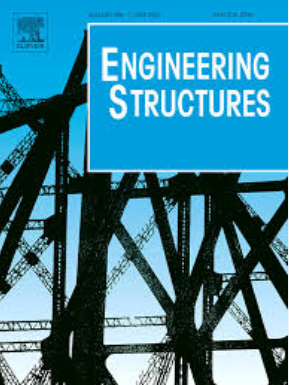DIMMC: A 3D vision approach for structural displacement measurement using a moving camera
IF 5.6
1区 工程技术
Q1 ENGINEERING, CIVIL
引用次数: 0
Abstract
Structural displacement is an essential data for engineers to evaluate the health and safety of civil structures. Computer vision-based displacement measurement has become increasingly popular due to accessibility and cost-effectiveness. While most of the studies in this area have been focused on analysing footage taken by static cameras, the usage of moving cameras such as those mounted on Unmanned Aerial Vehicles (UAVs) presents a transformative opportunity for structural health monitoring (SHM). Moving cameras enable flexible and scalable displacement measurement, allowing inspections in hard-to-reach areas without the constraints of fixed installation points. This paper proposes a deep learning-based, purely computer vision system that requires no auxiliary devices, for measuring structural displacement using monocular footage from a single moving camera. This system utilizes a Vision Transformer (ViT)-based mesh deformation neural network to reconstruct 3D geometry from a single image. State-of-the-art deep learning models for object segmentation and tracking are also used to isolate relevant objects from the background. To convert the reconstructed coordinate system into real-world coordinates, a 3D point registration method is introduced. The system eliminates the need for installing artificial targets or detecting key points on the structure, enhancing the robustness of the measurement process. The effectiveness and accuracy of the proposed approach are verified through experimental tests on beam-shaped structures, with cross-correlation coefficients exceeding 0.97 and mean absolute percentage errors remaining below 33 % for dynamic test. These findings underscore the accuracy of the proposed approach and its promising potential for practical applications.
DIMMC:一种使用移动摄像机进行结构位移测量的3D视觉方法
结构位移是工程师评价土建结构健康与安全的重要数据。基于计算机视觉的位移测量由于其可及性和成本效益而越来越受欢迎。虽然这一领域的大多数研究都集中在分析静态摄像机拍摄的镜头上,但移动摄像机(如安装在无人机上的摄像机)的使用为结构健康监测(SHM)提供了一个变革的机会。移动摄像机可以实现灵活和可扩展的位移测量,可以在没有固定安装点限制的情况下对难以到达的区域进行检查。本文提出了一种基于深度学习的纯计算机视觉系统,该系统不需要辅助设备,用于使用单个移动摄像机的单目镜头测量结构位移。该系统利用基于视觉变压器(Vision Transformer, ViT)的网格变形神经网络从单幅图像重建三维几何结构。用于对象分割和跟踪的最先进的深度学习模型也用于从背景中分离相关对象。为了将重建的坐标系转换为真实坐标系,引入了一种三维点配准方法。该系统不需要在结构上安装人工目标或检测关键点,增强了测量过程的鲁棒性。通过对梁型结构的试验验证了该方法的有效性和准确性,动态试验的相关系数大于0.97,平均绝对百分比误差小于33 %。这些发现强调了所提出的方法的准确性及其在实际应用中的良好潜力。
本文章由计算机程序翻译,如有差异,请以英文原文为准。
求助全文
约1分钟内获得全文
求助全文
来源期刊

Engineering Structures
工程技术-工程:土木
CiteScore
10.20
自引率
14.50%
发文量
1385
审稿时长
67 days
期刊介绍:
Engineering Structures provides a forum for a broad blend of scientific and technical papers to reflect the evolving needs of the structural engineering and structural mechanics communities. Particularly welcome are contributions dealing with applications of structural engineering and mechanics principles in all areas of technology. The journal aspires to a broad and integrated coverage of the effects of dynamic loadings and of the modelling techniques whereby the structural response to these loadings may be computed.
The scope of Engineering Structures encompasses, but is not restricted to, the following areas: infrastructure engineering; earthquake engineering; structure-fluid-soil interaction; wind engineering; fire engineering; blast engineering; structural reliability/stability; life assessment/integrity; structural health monitoring; multi-hazard engineering; structural dynamics; optimization; expert systems; experimental modelling; performance-based design; multiscale analysis; value engineering.
Topics of interest include: tall buildings; innovative structures; environmentally responsive structures; bridges; stadiums; commercial and public buildings; transmission towers; television and telecommunication masts; foldable structures; cooling towers; plates and shells; suspension structures; protective structures; smart structures; nuclear reactors; dams; pressure vessels; pipelines; tunnels.
Engineering Structures also publishes review articles, short communications and discussions, book reviews, and a diary on international events related to any aspect of structural engineering.
 求助内容:
求助内容: 应助结果提醒方式:
应助结果提醒方式:


